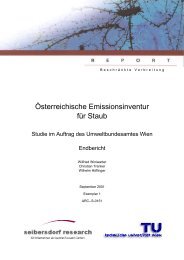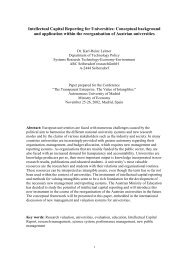ALPMON FINAL REPORT - ARC systems research
ALPMON FINAL REPORT - ARC systems research
ALPMON FINAL REPORT - ARC systems research
You also want an ePaper? Increase the reach of your titles
YUMPU automatically turns print PDFs into web optimized ePapers that Google loves.
Contract ENV4-CT96-0359 <strong>ALPMON</strong><br />
1 Introduction<br />
The Alpine environment, one of the most sensitive of Europe's terrestrial eco<strong>systems</strong>, is exposed to<br />
immediate and considerable environmental threat. The International Convention on the Protection of<br />
the Alps demands comprehensive counter-measures and recommends that an Alpine information<br />
system should be implemented. The goal of the project was to compile a basic landscape register for<br />
an Alpine Monitoring System (<strong>ALPMON</strong>) by means of combined analysis of diverse satellite sensors of<br />
Alpine landscapes selected for their typical characteristics. This system shall serve as the basis for<br />
planning proposals. The feasibility of the Alpine Monitoring System was tested using specific<br />
applications in the fields of disaster management, tourism management and national park<br />
management as well as by merging the results with CORINE-Landcover. These applications were<br />
carried out in close co-operation with the responsible experts so that the procedures developed can be<br />
put into practice.<br />
1.1 Objectives<br />
While the Alps represent one of the most sensitive eco<strong>systems</strong> in Europe the pressure on them, due to<br />
an aggressive development drive in the past, huge numbers of tourists as well as environmental<br />
damage, is far greater than on other environments. Forests have recently been subjected to<br />
particularly damaging natural as well as human influences. New kinds of damage to forests, the<br />
catastrophic storms of 1990 and 1999, and the resultant, and lasting problem of the bark beetle, and<br />
global climatic changes have weakened the resilience of alpine forests. Far-reaching changes have<br />
also been anticipated for agricultural land. Intensive farming and the excessive use of fertilisers,<br />
overgrazing, forest grazing, and grass-cutting adversely diminish the potential of the alpine regions as<br />
agricultural patrimony. Concurrently with this development we also find that more and more alpine<br />
pastures are no longer being grazed or cultivated, so that the pastures are gradually taken over by<br />
spreading forest. The resultant change in the face of the landscape typically associated with the Alps<br />
has a negative impact on tourism, an important economic factor. A third area of concern is the use of<br />
alpine land for tourism which increasingly is at odds with the aims of nature and landscape<br />
preservation. The cumulative effect of all these factors often proves disastrous, resulting in irreversible<br />
changes in the composition and distribution of regional plant communities as well as in agricultural and<br />
forest areas.<br />
The International Convention on the Protection of the Alps (short: Alpine Convention) thus concluded<br />
that alpine environment is under imminent threat, and demands comprehensive counter-measures.<br />
Far-sighted national and cross-border planning, considering the manifold and often competitive land<br />
use claims, is necessary to ensure that preventive measures can be implemented by nature<br />
conservation councils, regional planning departments, tourist boards and forestry and agricultural<br />
authorities. The success of such measures crucially depends on the availability of information about<br />
the land cover/land use patterns found and their development dynamics. It is not sufficient to record<br />
alpine sub<strong>systems</strong> using high-resolution equipment. Rather, information concerning the development<br />
of regional structures over wider areas needs to be included. Some inventory projects undertaken<br />
today at least partly meet this requirement (e.g. Berchtesgaden National Park), yet due to the high cost<br />
and labour intensity associated with the processing of aerial photographs and ground analyses these<br />
investigations are generally restricted to small areas.<br />
Satellite remote sensing represents an ideal instrument for objective, large-scale and updateable data<br />
acquisition especially of data related to regional structures and used as a basis for the planning of<br />
corrective measures and their monitoring. Moreover, compared to other inventory <strong>systems</strong> it offers a<br />
highly cost efficient alternative. One further advantage of this instrument is the fact that satellite images<br />
can synoptically record wider areas, and another the fact that using this data it is possible to observe<br />
the same areas repeatedly which permits monitoring over many years. The latter is essential when<br />
dealing with a sensitive ecosystem such as the Alps.<br />
1.2 Aim and Context of <strong>ALPMON</strong><br />
The project aimed at the compilation of a basic landscape register for an alpine monitoring system<br />
(<strong>ALPMON</strong>) which shall serve as the basis for planning purposes. The components of the alpine<br />
monitoring system were, firstly, derived from the results of a classification of TM, SPOT and high<br />
resolution satellite images and, secondly, extrapolated from thematic maps. The remote sensing data<br />
results represent the most up-to-date GIS level, which can provide information about the alpine<br />
JR, RSDE, ALU, LMU, Seibersdorf, WSL 5




